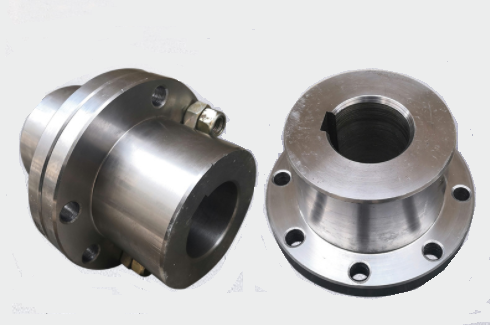Differences Between Roller Chain Couplings and Gear Couplings

Differences Between Roller Chain Couplings and Gear Couplings
1. Structural Differences
Roller Chain Coupling:
•Utilizes a double-row chain to simultaneously engage with two parallel sprockets (with identical tooth counts), connecting the two half-couplings.
Gear Coupling:
•Composed of two external gear hubs (with spherical-tooth-tip drum-shaped external teeth) and two internal gear sleeves (matching tooth count).
•The sleeves are key-connected to the shafts, while the hubs are bolted together.
•Sealed cavities store lubricating oil for enhanced durability.
2. Advantages
Roller Chain Coupling:
•Simple structure, compact size, lightweight.
•Easy installation, maintenance, and low cost.
•Moderate compensation capability and damping properties.
Gear Coupling:
•High torque transmission capacity.
•Effective compensation for combined displacements (axial, radial, angular).
 |
| gear coupling |
3. Disadvantages
Roller Chain Coupling:
•Unsuitable for reverse motion, frequent starts, vertical shaft transmission, or high-speed applications.
Gear Coupling:
•Bulky design and higher manufacturing cost.
4. Application Scope
Roller Chain Coupling:
•Ideal for low-speed, light-load applications (e.g., general machinery).
Gear Coupling:
•Designed for heavy-duty transmission scenarios (e.g., rolling mills, mining equipment).
•Precision-balanced variants can handle high-speed operations (e.g., steam turbine systems).
5. Technical Features
Gear Coupling (Drum Tooth Type):
•Drum-shaped teeth (arc profile) enable superior angular compensation compared to straight-tooth designs.
•Widely adopted in industries due to its robustness and adaptability.
Roller Chain Coupling:
•Simple assembly (4 components), no axial displacement required during disassembly.
•Operates reliably in harsh conditions (high temperature, humidity, dust).
•Limitations: Avoid shock loads in reverse motion; requires lubrication and protective housing.
6. Specifications (Roller Chain Coupling)
•13 standard sizes available.
•Shaft bore diameter: d = 16–190 mm
•Shaft bore length: L = 42–352 mm
•Rated torque: T = 40–25,000 N•m
•Permitted rotational speed [n]:
o200–1,400 rpm (without housing)
o900–4,500 rpm (with protective housing installed).
https://www.timothyholding.com/Roller-Chain-Couplings-and-Gear-Couplings.html
No comments:
Post a Comment